Comprehending The Definition Behind Your Automobile'S Caution Lighting: A Comprehensive Look
Comprehending The Definition Behind Your Automobile'S Caution Lighting: A Comprehensive Look
Blog Article
Personnel Author-Lauritsen Stark
When you're behind the wheel, those beautiful warning lights on your dashboard can be a bit puzzling. Do https://audi-ecu-tuning40627.blogs100.com/30403396/examining-do-it-yourself-and-specialist-car-describing-what-you-must-know know what they're attempting to inform you regarding your vehicle's health? Understanding the relevance of these lights is important for your safety and security and the longevity of your automobile. So, the following time among those lights appears, wouldn't you want to analyze its message accurately and take the essential steps to resolve it?
Common Caution Lights and Interpretations
Recognize typical warning lights in your auto and understand their definitions to make certain safe driving.
One of the most normal caution lights consist of the check engine light, which signifies problems with the engine or discharges system. If https://gunnerpkfzu.elbloglibre.com/29891692/lasting-automobile-explaining-focusing-on-eco-friendly-products-and-techniques begins, it's vital to have your car checked promptly.
The oil pressure warning light indicates low oil pressure, needing prompt attention to avoid engine damages.
A flashing battery light might recommend a defective billing system, potentially leaving you stranded if not resolved.
The tire pressure tracking system (TPMS) light notifies you to reduced tire pressure, influencing car stability and gas performance. Ignoring this can bring about risky driving conditions.
The abdominal muscle light indicates a problem with the anti-lock braking system, jeopardizing your ability to quit promptly in emergency situations.
Finally, the coolant temperature level alerting light warns of engine getting too hot, which can result in serious damage otherwise dealt with quickly.
Understanding these usual caution lights will certainly aid you deal with concerns without delay and keep safe driving problems.
Value of Prompt Attention
Understanding the common caution lights in your auto is only the very first step; the significance of quickly dealing with these warnings can not be emphasized enough to guarantee your safety on the road.
When a warning light brightens on your dashboard, it's your auto's means of interacting a potential concern that needs attention. Neglecting these warnings can bring about more serious issues later on, compromising your security and potentially costing you a lot more in repairs.
Trigger interest to cautioning lights can stop malfunctions and crashes. For instance, a flashing check engine light could suggest a misfire that, if left neglected, can create damages to the catalytic converter. Resolving this promptly can conserve you from an expensive fixing.
Likewise, a brake system advising light could signal reduced brake liquid or worn brake pads, vital components for your safety when driving.
Do It Yourself Troubleshooting Tips
If you see a warning light on your dashboard, there are a couple of DIY repairing tips you can try before seeking professional assistance.
The initial step is to consult your vehicle's handbook to understand what the certain caution light suggests. In some cases the problem can be as easy as a loose gas cap triggering the check engine light. Tightening up the gas cap might resolve the problem.
https://www.abcactionnews.com/news/local-news/aaa-shares-car-care-maintenance-tips-ahead-of-thanksgiving-travel is a reduced battery, which can activate different advising lights. Examining the battery connections for rust and guaranteeing they're secure might repair the trouble.
If a caution light lingers, you can try resetting it by detaching the cars and truck's battery for a few minutes and then reconnecting it. In addition, checking your vehicle's fluid levels, such as oil, coolant, and brake liquid, can help repair warning lights related to these systems.
Conclusion
In conclusion, recognizing your auto's warning lights is important for keeping your car running efficiently and safely. By quickly dealing with these notifies and knowing what they mean, you can stay clear of pricey fixings and prospective malfunctions.
Bear in mind to consult your automobile's handbook for specific details on each cautioning light and act appropriately to make sure a trouble-free driving experience.
Keep informed, stay secure on the road!
